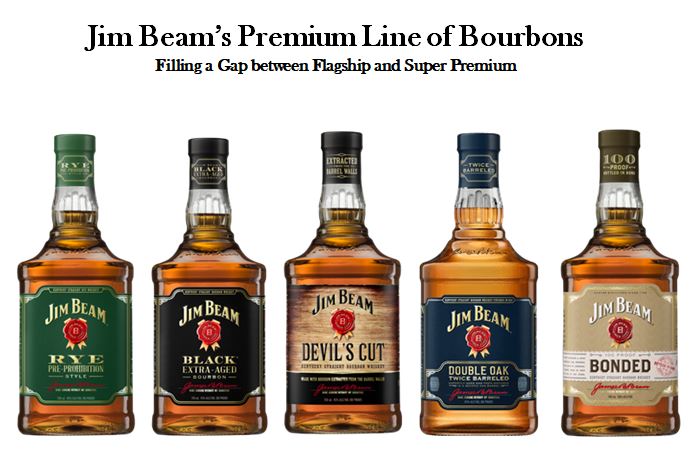Colonel James Beauregard “Jim” Beam
“The Namesake”
The Beginning. In 1740, the German Boehm family arrived in Pennsylvania of the 13 colonies in Colonial America, determined to make a better life for themselves and their children. Nearly five decades later, they moved to what is now Kentucky and altered their name to the more Americanized “Beam”. In Kentucky, the long, hot summers, mild winters, and plenty of clean, pure limestone water made their new home ideal for two things the newly monikered “Beams” were good at: growing corn and making whiskey. The family’s patriarch was Jacob Beam, who named his new distillery “Old Tub”. In 1820, Jacob handed the operation of the distillery over to his son, David. The industrious and forward-thinking David quickly enlarged the distillery and changed to column stills for continuous operation. He also named the bourbon “Old Tub” to match the distillery name. Soon after taking over the distillery, the 31-year-old David married Margaret Ellen Phillips, who was 21. Before long, James Beauregard “Jim" Beam was born in Washington, Kentucky, on August 25, 1864.
Barrel Innovation. During this period, with the arrival of steamboats and trains, David Beam could ship his bourbon almost anywhere relatively quickly. The demand for whiskey soon created a barrel shortage, so Beam began to put bourbon in used barrels, some having previously contained vinegar or fish. Needless to say, this initially resulted in off-putting side effects for the whiskey. Ever-industrious, though, distillers like the Beam family soon found that burning (or charring) the insides of the barrels completely removed the odor and grease, preparing the barrels ideally for whiskey transport and storage. The side effect of charring the barrels had also resulted in the whiskey turning a beautiful amber color and taking on the caramelized vanilla and dried fruit notes that are still much-sought after today.
Family Expansion. It was during this period that the 33-year-old Jim Beam married Mary Catherine Montgomery on September 9, 1897. Soon, three children were born of the union: son and future partner and master distiller Thomas Jeremiah ‘Jere’ Beam in 1899, and daughters Mildred in 1901, then Margaret in 1904.
A Calling Finally Realized. Although by the early 1900s, Old Tub had become a well-known national brand, as (bad) luck would have it, Jim took over the Distillery from his father, David, just before Prohibition halted whiskey production nationwide. During those dark days of being unable to distill, Jim bought acreage and tried his hand at farming; he failed. Then he bought a quarry business, and it also failed. He took a shot at mining as well as citrus farming. Both ventures failed miserably. He was so bad at business that it was said that if Jim Beam decided to open a funeral home in town, everyone in Bardstown would stop dying. It seemed that the only thing Jim Beam could do well was make whiskey. Unfortunately, for the 13 long years of Prohibition in Kentucky, Jim Beam was forced to give up his life’s work—this was the only time in over 225 years that the Beam family didn’t distill bourbon.
The Future. Finally, with Prohibition repealed in 1933, Jim Beam worked hard to protect his bourbon’s destiny. With the help of friends and family, he rebuilt his distillery in Clermont by hand. To ensure the signature flavor of his liquor, it was said that every weekend, Jim brought a jug of his prized yeast strain home for safekeeping. One good thing that had happened to the Beam family during Prohibition is that Jim’s daughter, Margaret, had married Frederick Booker Noe. Their son, Frederick Booker Noe II, would become a future master distiller, carrying on the Beam family tradition.
Expansion. In 1934, Colonel Beam, now at the age of 70, went into partnership with his son Jere and two businessmen from Chicago. The associates bought the old Murphy Barber distillery and insisted on the same Distilled Spirits Producer number (DSP#) that it had originally been granted. They started making whiskey again under the Old Tub and Pebble-Ford labels. However, the new enterprise was now renamed the ‘James B. Beam Distilling Company,’ and it filled its first barrel in 1935. From this point forward, the bourbon produced there would be called "Jim Beam Bourbon,” and the bottle labels would bear the trademark, "None Genuine Without My Signature," and would contain the bold, proud inscription of James B. Beam.
Honoring the Legend. After Jim Beam passed away on December 27, 1947, at the age of 83, Jere launched the brand "Jim Beam Black" to honor his father. By that time, Jim Beam White Label had become the #1 selling bourbon in the world, and remains so today. Jim Beam was inducted posthumously into the Kentucky Bourbon Hall of Fame in 2002, in only its second class of inductees ever. Ironically, the company's namesake was the third of eleven Beam family members to be inducted into the Bourbon Hall of Fame behind Jim’s grand-nephew, Parker Beam, and his grandson, Booker Noe.
Submitted by Tracy McLemore, Fairview, Tennessee









